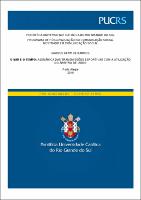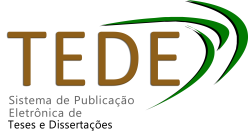| Share record |


|
Please use this identifier to cite or link to this item:
https://tede2.pucrs.br/tede2/handle/tede/8692Full metadata record
| DC Field | Value | Language |
|---|---|---|
| dc.creator | Barros, Mateus Kerr de | - |
| dc.creator.Lattes | http://lattes.cnpq.br/4199385544740812 | por |
| dc.contributor.advisor1 | Gerbase, Carlos | - |
| dc.contributor.advisor1Lattes | http://lattes.cnpq.br/4409574076875237 | por |
| dc.date.accessioned | 2019-06-13T12:35:19Z | - |
| dc.date.issued | 2019-04-24 | - |
| dc.identifier.uri | http://tede2.pucrs.br/tede2/handle/tede/8692 | - |
| dc.description.resumo | Este trabalho tem por intuito desvendar as modificações nas teletransmissões esportivas a partir da implementação do VAR - o árbitro de vídeo, no futebol. O objetivo é entender como a dinâmica do esporte, afetada pela utilização do novo recurso eletrônico, é trabalhada na televisão. A experiência de assistir a uma partida de futebol através de um aparelho televisivo será a mesma daqui para frente? Como os responsáveis pelas transmissões estão trabalhando com estes novos elementos do jogo para a construção das suas narrativas? Para entender: o VAR (sigla para Video Assistant Referee, em inglês) é um sistema eletrônico de apoio à arbitragem e foi utilizado pela primeira vez em uma Copa do Mundo em 2018, na Rússia. Cada uma das 64 partidas do Mundial contou com uma equipe composta por um árbitro de vídeo e três auxiliares. Os profissionais trabalharam em um amplo estúdio instalado em Moscou durante a competição. Ao longo deste trabalho, analisamos 18 lances de 14 jogos diferentes em que o recurso eletrônico foi utilizado. Os critérios para a escolha das jogadas foram o ineditismo e/ou a relevância histórica dos exemplos destacados. Concluímos que, em alguns casos, as transmissões televisivas seguiram determinados padrões, mas que uma série de ruídos prejudicou o entendimento dos telespectadores frente ao que estava sendo exibido em alguns dos objetos analisados. Além disso, trouxemos à tona algumas questões que podem ser modificadas com o intuito de tornar o produto VAR mais atrativo e dota-lo de uma maior transparência. | por |
| dc.description.abstract | In this document, we want to find out what`s changing in the sports teletransmissions with the VAR´s arrival - the Video Assistant Referee, in football. We´re trying to understand how the sports dynamic, affected due to the arise of the new eletronic resources, will be showed on the tv stations. Will the experience of watch a football match in a television be the same? How the broadcasters are working with these new elements and how they´re been put in their narratives? To understand: VAR (Video Assistant Referee) is an eletronic system developed to help the football referees, and it was used for the first time in a World Cup in 2018, Russia. A team formed by one Video Referee and three assistants worked in each one of the 64 matches of this championship. These professionals worked in a big studio, installed in Moscow during the competition. Through this document, we analysed 18 situations of 14 different matches where the eletronical system was required. We´d selected this situations of the football game due to their ineditism or historical relevance. We concluded that the teletransmition followed certain patterns, but some "noises", like we use to say in the TV vocabulary, have difficulted the understanding process of the viewers in some cases. We also brough some questions that might be modified to turn the VAR product into something more atractive and with more transparency. | eng |
| dc.description.provenance | Submitted by PPG Comunicação Social ([email protected]) on 2019-05-23T18:51:29Z No. of bitstreams: 1 MATEUS_KERR_DE_BARROS_DIS.pdf: 3656964 bytes, checksum: 808ec0c40b3cc43b11169c02586406fd (MD5) | eng |
| dc.description.provenance | Approved for entry into archive by Caroline Xavier ([email protected]) on 2019-06-13T12:32:13Z (GMT) No. of bitstreams: 1 MATEUS_KERR_DE_BARROS_DIS.pdf: 3656964 bytes, checksum: 808ec0c40b3cc43b11169c02586406fd (MD5) | eng |
| dc.description.provenance | Made available in DSpace on 2019-06-13T12:35:19Z (GMT). No. of bitstreams: 1 MATEUS_KERR_DE_BARROS_DIS.pdf: 3656964 bytes, checksum: 808ec0c40b3cc43b11169c02586406fd (MD5) Previous issue date: 2019-04-24 | eng |
| dc.description.sponsorship | Conselho Nacional de Pesquisa e Desenvolvimento Científico e Tecnológico - CNPq | por |
| dc.format | application/pdf | * |
| dc.thumbnail.url | http://tede2.pucrs.br:80/tede2/retrieve/175518/MATEUS_KERR_DE_BARROS_DIS.pdf.jpg | * |
| dc.language | por | por |
| dc.publisher | Pontifícia Universidade Católica do Rio Grande do Sul | por |
| dc.publisher.department | Escola de Comunicação, Arte e Design | por |
| dc.publisher.country | Brasil | por |
| dc.publisher.initials | PUCRS | por |
| dc.publisher.program | Programa de Pós-Graduação em Comunicação Social | por |
| dc.rights | Acesso Aberto | por |
| dc.subject | VAR | por |
| dc.subject | Árbitro de Vídeo | por |
| dc.subject | Jornalismo Esportivo | por |
| dc.subject.cnpq | CIENCIAS SOCIAIS APLICADAS::COMUNICACAO | por |
| dc.title | O VAR e o tempo : a dinâmica das transmissões esportivas com a utilização do árbitro de vídeo | por |
| dc.type | Dissertação | por |
| dc.restricao.situacao | Trabalho não apresenta restrição para publicação | por |
| Appears in Collections: | Programa de Pós-Graduação em Comunicação Social | |
Files in This Item:
| File | Description | Size | Format | |
|---|---|---|---|---|
| MATEUS_KERR_DE_BARROS_DIS.pdf | MATEUS_KERR_DE_BARROS_DIS | 3.57 MB | Adobe PDF |  Download/Open Preview |
Items in DSpace are protected by copyright, with all rights reserved, unless otherwise indicated.




